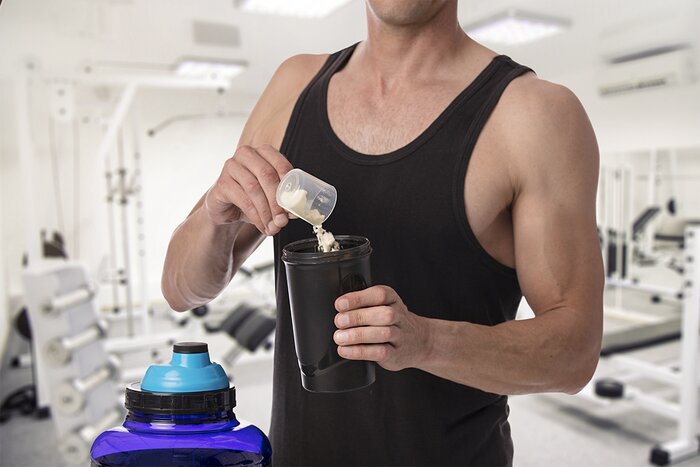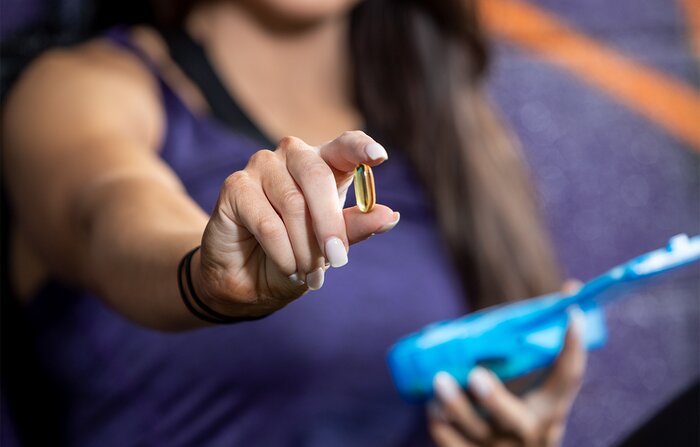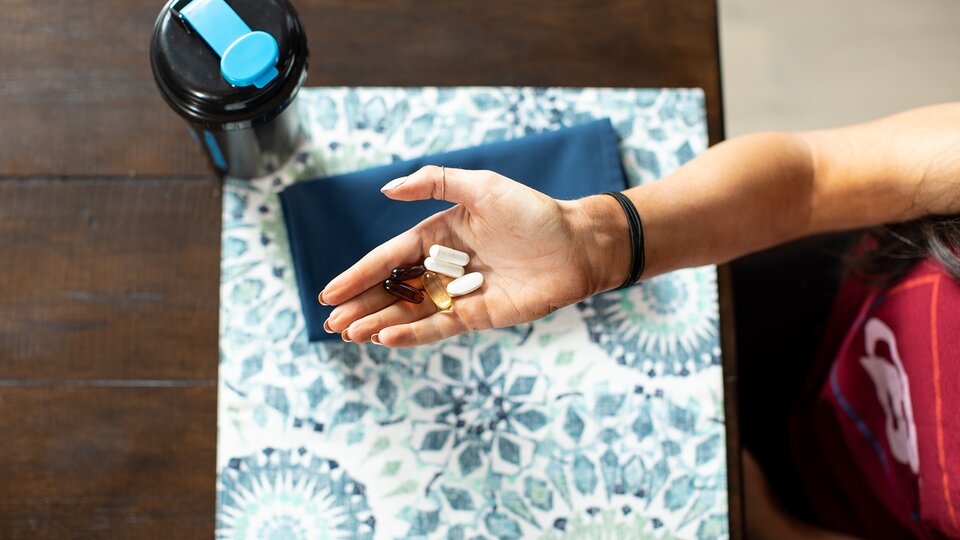A diet consisting of clean, unprocessed foods is always the best place to start your fat-loss journey; supplementing a crappy diet with a fat burner won’t cut it! Sound nutrition ensures you’ll get the crucial macronutrients and micronutrients your body demands for optimal performance and recovery. So yeah, eat your vegetables and proteins, because they haven’t invented a substitute for them yet.
However, there’s no doubt that it can be especially hard to recover adequately, meet your macros, and train hard when cutting. If a shake or a scoop a day could make a difference between an epic struggle and feeling surprisingly all right, why not let it?
Ditch the ordinary shred—the one where you’re miserable, grumpy, sore, and under-recovered between workouts—and aim for an extraordinary experience. Here’s how to use a few key supps to make it happen.
Lean Out with Whey
Protein is your friend while shredding down! Don’t let that outdated societal cliché of protein shakes being only for “bulking” get in the way of your results.
If your goal is to get shredded, a quality whey protein should be a top priority. Besides stimulating muscle protein synthesis and helping your muscles repair and recover after a tough workout, increased protein consumption is associated with higher rates of satiety (feeling of fullness) and thermogenesis (energy expenditure).[1]*

Dose: Simply adding an extra 20 grams of whey protein per day has been shown to increase fat loss over a placebo.[2]* Take it post-workout, but also as a meal replacement when necessary.
Use Caffeine and Green Tea Pre-Workout
A sound diet and a solid training approach are critical for a shred, but if you’re ready to ramp up your results, look no further than caffeine. Don’t get me wrong—you still have to put time into the gym, but studies have shown that caffeine-containing supplements can increase the rate of fat breakdown and reduce perceived exertion during exercise.[3,4]*
In other words, you can expect an increased rate of fat burning and a seemingly easier workout. Doesn’t get much better than that, does it?
Looking for another tried-and-true fat-burning ally? Try green tea extract—or more specifically, EGCG, the primary ingredient in green tea extract that’s responsible for boosting metabolic rate.[5] Taken together, the combination of EGCG and caffeine have been shown to be more effective when it comes to fat loss and increased energy.[6]*
Dose: Take 200-300 milligrams of caffeine 30-60 minutes before your workout—the timing is important, because you have to give it time to start working! New to the supplemental caffeine club? Start with 150 milligrams and adjust accordingly. At the same time you take it, take 400 milligrams of EGCG from a green tea extract.
Take Fish Oil Twice a Day
Still thinking fat can make you fat? You couldn’t be more wrong. In fact, certain types of fat—like fish oil—can actually help you lose body fat while increasing fat-free mass.[7,8] Supplementing with omega-3s has actually been shown to help your body burn more fat while also increasing rates of protein synthesis and muscle gain.[9]*

Another benefit to supplementing with fish oil is its ability to reduce some of the inflammation and soreness associated with dieting and higher amounts of exercise, allowing you to recover faster and make the most of your time in the gym.[10]*
Dose: To maximize the benefits of omega-3s, get 3-4 grams of EPA+DHA daily, split into two equal doses.
Don’t Just Take Beta-Alanine in Your Pre-Workout
If you’re following a fat-loss-focused plan like Shortcut to Shred or The One-Month Six-Pack, you know that training for leanness can be, in a word, intense. Higher reps, minimal rest time, and advanced training techniques like dropsets can help you challenge your muscles and burn serious calories, but they can also leave you feeling wrecked by your third set.
When you train at higher intensities, the accumulation of hydrogen ions lowers your blood’s pH levels and contributes to fatigue. Carnosine, the amino acid that beta-alanine helps to produce in your body, serves to buffer hydrogen ions, allowing you to work at higher intensities for longer periods of time.[11]*
Dose: Take 3-6 grams of beta-alanine daily. Consider taking it in multiple doses to avoid the skin-tingling sensation if that bothers you.
Take Vitamin D with Calcium
An often overlooked combo, calcium and vitamin D can play a pivotal role in fat loss. A calcium-rich diet has been shown to increase rates of fat oxidation, reduce fat absorption, and help control appetite, while vitamin D intake is related to lower levels of body fat and improved metabolic health.[12-15]*
Supplementing with this duo will have little effect if your diet already contains sufficient levels of these two nutrients, but if your dairy or fat intake has taken a hit in your efforts to become shredded, adding them back into your diet via supplementation may lead to greater weight loss over time.*
Dose: Look for a supplement containing 600 milligrams of calcium and 125 IU of vitamin D3.
*These statements have not been evaluated by the Food and Drug Administration. This product is not intended to diagnose, treat, cure, or prevent any disease.
Ready to shred the right way? Use Jim Stoppani’s 6-Week Shortcut to Shred in BodyFit. This legendary plan has helped thousands lean out like they didn’t think was possible, all while holding onto muscle mass and boosting their cardiovascular conditioning. It’s tough, but boy is it effective!
References
- Weiss, L. W., Cureton, K. J., & Thompson, F. N. (1983). Comparison of serum testosterone and androstenedione responses to weight lifting in men and women. European Journal of Applied Physiology and Occupational Physiology, 50(3), 413-419.
- Johnston, C. S., Day, C. S., & Swan, P. D. (2002). Postprandial thermogenesis is increased 100% on a high-protein, low-fat diet versus a high-carbohydrate, low-fat diet in healthy, young women. Journal of the American College of Nutrition, 21(1), 55-61.
- Frestedt, J. L., Zenk, J. L., Kuskowski, M. A., Ward, L. S., & Bastian, E. D. (2008). A whey-protein supplement increases fat loss and spares lean muscle in obese subjects: a randomized human clinical study. Nutrition & Metabolism, 5(1), 8.
- Costill, D. L., Dalsky, G. P., & Fink, W. J. (1977). Effects of caffeine ingestion on metabolism and exercise performance. Medicine and Science in Sports, 10(3), 155-158.
- Arciero, P. J., Bougopoulos, C. L., Nindl, B. C., & Benowitz, N. L. (2000). Influence of age on the thermic response to caffeine in women. Metabolism: Clinical and Experimental, 49(1), 101-107.
- Nagao, T., Hase, T., & Tokimitsu, I. (2007). A green tea extract high in catechins reduces body fat and cardiovascular risks in humans. Obesity, 15(6), 1473-1483.
- Hill, A. M., Buckley, J. D., Murphy, K. J., & Howe, P. R. C. (2007). Combining fish-oil supplements with regular aerobic exercise improves body composition and cardiovascular disease risk factors. The American Journal of Clinical Nutrition, 85(5), 1267-1274.
- Noreen, E. E., Sass, M. J., Crowe, M. L., Pabon, V. A., Brandauer, J., & Averill, L. K. (2010). Effects of supplemental fish oil on resting metabolic rate, body composition, and salivary cortisol in healthy adults. Journal of the International Society of Sports Nutrition, 7(1), 31.
- Smith, G. I., Atherton, P., Reeds, D. N., Mohammed, B. S., Rankin, D., Rennie, M. J., & Mittendorfer, B. (2011). Omega-3 polyunsaturated fatty acids augment the muscle protein anabolic response to hyperinsulinaemia-hyperaminoacidaemia in healthy young and middle-aged men and women. Clinical Science, 121(6), 267-278.
- Burke, K. A., Ebelhar, J. L., & Weiss, E. P. (2009). The Effect Of Omega-3 Fatty Acid Supplementation On The Inflammatory Response To Eccentric Strength Exercise. Medicine & Science in Sports & Exercise, 41(5), 185.
- Harris, R. C., & Stellingwerff, T. (2013). Effect of beta-alanine supplementation on high-intensity exercise performance. Nestlé Nutrition Institute Workshop Series, 76, 61-71.
- Caron-Jobin, M., Morisset, A. S., Tremblay, A., Huot, C., Légaré, D., & Tchernof, A. (2011). Elevated serum 25 (OH) D concentrations, vitamin D, and calcium intakes are associated with reduced adipocyte size in women. Obesity, 19(7), 1335-1341.
- Sulistyoningrum, D. C., Green, T. J., Lear, S. A., & Devlin, A. M. (2012). Ethnic-specific differences in vitamin D status is associated with adiposity. PloS One, 7(8), e43159.
- Jacqmain, M., Doucet, E., Després, J. P., Bouchard, C., & Tremblay, A. (2003). Calcium intake, body composition, and lipoprotein-lipid concentrations in adults. The American Journal of Clinical Nutrition, 77(6), 1448-1452.
- Gonzalez, A. J., White, E., Kristal, A., & Littman, A. J. (2006). Calcium intake and 10-year weight change in middle-aged adults. Journal of the American Dietetic Association, 106(7), 1066-1073.
